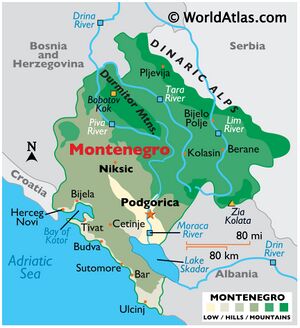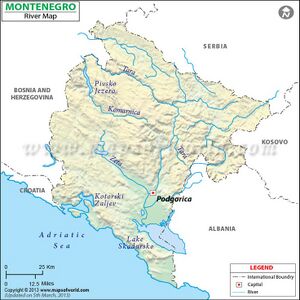Montenegro
| Author:Laxman Burdak, IFS (R) |


Montenegro (मॉन्टेनीग्रो) is a country in Southeastern Europe.[1] Podgorica is the capital and largest city.
Variants
- Montenegrin (मॉन्टेनीग्रिन)
- Crna Gora (Albanian: Mali i Zi) (Written identically in Bosnian, Croatian and Serbian)
- Црна Гора (Written identically in Serbian Cyrillic.)
Origin of name
Montenegro = lit. 'Black Mountain'[2][3]
The country's English name derives from Venetian and translates as "Black Mountain", deriving from the appearance of Mount Lovćen when covered in dense evergreen forests.[4]
The native name Crna Gora, also meaning "black mountain" or "black hill", was mentioned for the first time in a charter issued by Stefan Milutin.[5] It came to denote the majority of contemporary Montenegro in the 15th century.[6] Modern-day Montenegro was more and more known by that name in the historical period following the fall of the Serbian Despotate.[7] Originally, it had referred to only a small strip of land under the rule of the Paštrovići tribe, but the name eventually came to be used for the wider mountainous region after the Crnojević noble family took power in Upper Zeta.[8] The aforementioned region became known as Stara Crna Gora 'Old Montenegro' by the 19th century to distinguish the independent region from the neighbouring Ottoman-occupied Montenegrin territory of Brda '(The) Highlands'. Montenegro further increased its size several times by the 20th century, as the result of wars against the Ottoman Empire, which saw the annexation of Old Herzegovina and parts of Metohija and southern Raška. Its borders have changed little since then, losing Metohija and gaining the Bay of Kotor.
After the second session of the AVNOJ during World War II in Yugoslavia, the contemporary modern state of Montenegro was founded as the Federal State of Montenegro (Montenegrin: Савезна држава Црне Горе / Savezna država Crne Gore) on 15 November 1943 within the Yugoslav Federation by the ZAVNOCGB. After the war, Montenegro became a republic under its name, the People's Republic of Montenegro (Montenegrin: Народна Република Црна Гора / Narodna Republika Crna Gora) on 29 November 1945. In 1963, it was renamed to the Socialist Republic of Montenegro (Montenegrin: Социјалистичка Република Црна Гора / Socijalistička Republika Crna Gora). As the breakup of Yugoslavia occurred, the SRCG was renamed to the Republic of Montenegro (Montenegrin: Република Црна Гора / Republika Crna Gora) on 27 April 1992 within the Federal Republic of Yugoslavia by removing the adjective "socialist" from the republic's title. Since 22 October 2007, a year after its independence, the name of the country became simply known as Montenegro.
Location
It is located on the Adriatic Sea and is a part of the Balkans, sharing borders with Serbia to the northeast, Bosnia and Herzegovina to the north, Kosovo to the east and Albania to the southeast, the Adriatic Sea and Croatia to the northwest, and a maritime boundary with Italy.[9]
History
Antiquity: Modern-day Montenegro was part of Illyria and populated by the Indo-European-speaking Illyrians.[10][11] The Illyrian kingdom was conquered by the Roman Republic in the Illyro-Roman Wars and was incorporated the region into the province of Illyricum (later Dalmatia and Praevalitana).[12][13][14]
Arrival of the Slavs: Three Slavic principalities were located on the territory: Duklja, roughly corresponding to the southern half, Travunia, the west, and Raška, the north.[15][16] Duklja gained its independence from the Byzantine Roman Empire in 1042. Over the next few decades, it expanded its territory to neighbouring Rascia and Bosnia, and also became recognised as a kingdom. Its power started declining at the beginning of the 12th century. After King Bodin's death (in 1101 or 1108), civil wars ensued. Duklja reached its zenith under Vojislav's son, Mihailo (1046–81), and his grandson Constantine Bodin (1081–1101).[17]
As the nobility fought for the throne, the kingdom was weakened, and by 1186, the territory of modern-day Montenegro became part of the state ruled by Stefan Nemanja and was a part of various state formations ruled by the Nemanjić dynasty for the next two centuries. After the Serbian Empire collapsed in the second half of the 14th century, the most powerful Zetan family, the Balšićs, became sovereigns of Zeta.
By the 13th century, Zeta had replaced Duklja when referring to the realm. In the late 14th century, southern Montenegro (Zeta) came under the rule of the Balšić noble family, then the Crnojević noble family, and by the 15th century, Zeta was more often referred to as Crna Gora.
In 1421, Zeta was annexed to the Serbian Despotate, but after 1455, another noble family from Zeta, the Crnojevićs, became sovereign rulers of the country, making it the last free monarchy of the Balkans before it fell to the Ottomans in 1496, and got annexed to the sanjak of Shkodër. For a short time, Montenegro existed as a separate autonomous sanjak in 1514–1528 (Sanjak of Montenegro). Also, Old Herzegovina region was part of Sanjak of Herzegovina.
During the Early Medieval period, three principalities were located on the territory of modern-day Montenegro: Duklja, roughly corresponding to the southern half; Travunia, the west; and Rascia proper, the north.[18] The Principality of Zeta emerged in the 14th and 15th centuries. From the late 14th century to the late 18th century, large parts of southern Montenegro were ruled by the Venetian Republic and incorporated into Venetian Albania.[19] The name Montenegro was first used to refer to the country in the late 15th century. After falling under Ottoman rule, Montenegro regained its independence in 1696 under the rule of the House of Petrović-Njegoš, first as a theocracy and later as a secular principality. Montenegro's independence was recognised by the Great Powers at the Congress of Berlin in 1878. In 1910, the country became a kingdom.
After World War I, the kingdom became part of Yugoslavia. Following the breakup of Yugoslavia, the republics of Serbia and Montenegro together proclaimed a federation. Following an independence referendum held in May 2006, Montenegro declared its independence in June 2006 and the confederation dissolved.[20]
Tourism
With a total of 1.6 million visitors, Montenegro was, as of 2017, the 36th-most-visited country (out of 47) in Europe.[21] The majority of foreign visitors to Montenegro come from the neighbouring countries of Serbia, Bosnia and Herzegovina and Kosovo, as well as Russia.[22] The Montenegrin Adriatic coast is 295 km long, with 72 km of beaches and many well-preserved ancient towns. Some of the most popular beaches include Jaz Beach, Mogren Beach, Bečići Beach, Sveti Stefan Beach and Velika Plaža.[23] Meanwhile, some of the most popular ancient towns include Herceg Novi, Perast, Kotor, Budva and Ulcinj.[24]
National Geographic Traveler ranks Montenegro among the "50 Places of a Lifetime". Montenegrin seaside town Sveti Stefan was once used as the cover for the magazine.[25] The coast region of Montenegro was considered one of the great "discoveries" among world tourists. In January 2010, The New York Times ranked the Ulcinj South Coast region of Montenegro, including Velika Plaža, Ada Bojana, and the Hotel Mediteran of Ulcinj, among the "Top 31 Places to Go in 2010" as part of a worldwide ranking.[[26]
Montenegro was listed by Yahoo Travel among the "10 Top Hot Spots of 2009" to visit, describing it as "the second fastest growing tourism market in the world (falling just behind China)".[27] It is listed by tourism guides like Lonely Planet as a top destination[28]
Jat History
- Dugoli (दुगोली) is a village in Jayal tehsil of Nagaur district Rajasthan. It is inhabited by Burdak, Garu and Tholiya Jat clans. Dugoli is also a place in Serbia & Montenegro.
External links
References
- ↑ Montenegro – The World Factbook". www.cia.gov.
- ↑ "Влада Црне Горе". Vlada Crne Gore (in Montenegrin).
- ↑ "Vlada Crne Gore". Влада Црне Горе (in Montenegrin).
- ↑ "Montenegro History – Part I". visit-montenegro.com.
- ↑ Doe, John (9 October 2017). "Crna Gora:Istorijski razvoj". Eurydice – European Commission.
- ↑ [— (1994). The Late Medieval Balkans: A Critical Survey from the Late Twelfth Century to the Ottoman Conquest. The University of Michigan Press. ISBN 0-472-08260-4. p. 532]
- ↑ Zlatar, Zdenko (2007). The Poetics of Slavdom: The Mythopoeic Foundations of Yugoslavia. Dumbarton Oaks Library and Collection. p. 459. ISBN 978-0-88402-137-7.
- ↑ — (1994). The Late Medieval Balkans: A Critical Survey from the Late Twelfth Century to the Ottoman Conquest. The University of Michigan Press. ISBN 0-472-08260-4. p. 532
- ↑ "Montenegro – History". Encyclopedia Britannica.
- ↑ John Boardman. The prehistory of the Balkans and the Middle East and the Aegean world. Cambridge University Press, 1982. ISBN 978-0-521-22496-3, p. 629
- ↑ Wilkes John. The Illyrians. Wiley-Blackwell, 1995, ISBN 978-0-631-19807-9, p. 92
- ↑ ivy, The History of Rome, 45.26.11-15
- ↑ Appian, the Foreign Wars, The Illyrian wars, Book 10, The Illyirian Wars; Loeb Classical Library, Vol II, Books 8.2-12, Harvard University Press, 1912; ISBN 978-0674990043 [1], 10.18-27
- ↑ Cassius Dio, Roman History, Vol 6, Books 51-65 (Loeb Classical Library), Loeb, 1989; ISBN 978-0674990920 [2]? 49.37-38
- ↑ Luscombe, David; Riley-Smith, Jonathan (2004). The New Cambridge Medieval History: Volume 4, c. 1024 – c. 1198. Cambridge University Press. pp. 266–. ISBN 9780521414111.
- ↑ Sedlar, Jean W. (2013). East Central Europe in the Middle Ages, 1000–1500. University of Washington Press. pp. 21–. ISBN 9780295800646.
- ↑ "Duklja, the first Montenegrin state". Montenegro.org.
- ↑ Luscombe, David; Riley-Smith, Jonathan (2004). The New Cambridge Medieval History: Volume 4, c. 1024 – c. 1198. Cambridge University Press. pp. 266–. ISBN 9780521414111.
- ↑ Schmitt, Oliver Jens (2001). Das Venezianische Albanien (1392–1479). Walter de Gruyter. ISBN 978-3-486-56569-0.
- ↑ "Serbia ends union with Montenegro". The Irish Times. 5 June 2006.
- ↑ Hillsdon, Mark (27 February 2017). "The European capital you'd never thought to visit (but really should)". The Daily Telegraph. Archived
- ↑ "Foreign tourist arrivals and overnight stays by countries, 2017" (PDF).
- ↑ "Best Beaches". My Guide Montenegro.
- ↑ "Old Towns in Montenegro". My Guide Montenegro.
- ↑ "50 Places of a Lifetime". National Geographic.
- ↑ https://www.nytimes.com/2010/01/10/travel/10places.html?pagewanted=2&ref=travel "The 31 Places to Go in 2010". The New York Times. ]
- ↑ ["The 31 Places to Go in 2010". The New York Times. "10 Top Hot Spots of 2009 by Yahoo Travel". Yahoo!.]
- ↑ .Leue, Holger. "Where to go in June". Lonely Planet.
Back to Europe

